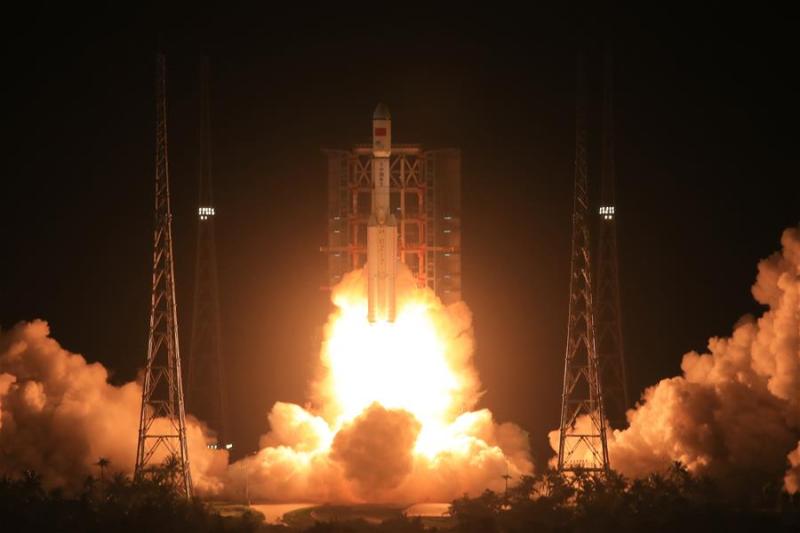Featured image: Xinhua News
Lift Off Time | May 9, 2022 |
|---|---|
Mission Name | Tianzhou 4 |
Launch Provider | China Aerospace Science Corporation (CASC) |
Customer | China National Space Administration (CNSA) |
Rocket | Long March 7 |
Launch Location | LC-201, Wenchang Satellite Launch Center, Hainan Island, China |
Payload mass | Up to 6,500 kg (14,300 lb) |
Where is the spacecraft going? | Tiangong Space Station, Low earth orbit (LEO) – 370 km (230 mi), at a 41.0° inclination |
Will they be attempting to recover the first stage? | No, this is not a capability of the Long March 7 |
Where will the first stage land? | It will crash into the ocean |
Will they be attempting to recover the fairings? | No, this is not a capability of the Long March 7 |
Are these fairings new? | Yes |
How’s the weather looking? | TBD |
This will be the: | – 3rd resupply mission for the Tiangong 3 Space Station – 4rd launch of a Tianzhou spacecraft – 8th mission of a Long March 7 rocket – 51st orbital launch attempt in 2022 |
Where to watch | If available, a livestream will be listed here |
What Does All This Mean?
The China Aerospace Science Corporation (CASC) will launch its third cargo resupply mission, the Tianzhou 4, to the Tiangong Space Station, which is currently under construction in low earth orbit (LEO). The rocket is scheduled to launch from LC-201, Wenchang Satellite Launch Center, in China on May 9, 2022.
What Is The Tianzhou 4?
The Tianzhou 4 mission is the third cargo resupply mission to the Tianhe core crew module (CCM) of China’s Tiangong Space Station. The mission will provide the Tianhe CCM with enough propellant to maintain its orbital altitude, as well as deliver supplies for the stations next astronauts, who will arrive at the station in June for the Shenzhou 14 mission. The Tianzhou 4 will attach to the aft docking port of the Tianhe CCM.
The Tianzhou (which means “heavenly boat”) is an automated cargo spacecraft which will function as the main resupply vehicle for the Tiangong Space Station. The spacecraft was developed from China’s first prototype space station, also called the Tiangong. The first Tianzhou spacecraft, the Tianzhou 1, launched on a Long March 7 rocket from Wenchang on April 2017.

The Tiangong Space Station
The Tiangong Space Station (meaning “heavenly palace”) is a space station currently under construction in low earth orbit (LEO). When complete the station will be roughly one-fifth the mass of the of the International Space Station. Construction began on April 29, 2021, when the core module, the Tianhe, which is able to accommodate three crew members with a built-in life support system, was launched on a Long March 5B rocket.
China’s aim is to construct the three-module space station with 11 launches across 2021-2022, which will include 3 module launches, 4 cargo spacecraft, and 4 crewed missions. The station will be comprised of three modules, though it has the ability to expand to 6, and it is expected to be operational for at least 10 years.
What Is The Long March 7?
The Long March 7 is a three stage medium lift launch vehicle, capable of placing a 13,500 kg (~29,800 lb) payload into low earth orbit (LEO), or a 7,000 kg (~15,000 lb) payload into geostationary transfer orbit (GTO).
The basic version of the Long March 7 can be customized by varying the number of boosters, allowing it to be capable of reaching higher orbits or executing multiple orbital deployments.

Boosters
The center core of the Long March 7 can be supported by either 0, 2, or 4 boosters, which use refined kerosene (RP-1) and liquid oxygen (LOx) propellent. The boosters are powered by an oxidizer-rich staged combustion YF-100 engine. At sea level, each booster provides 1,200 kN (270,000 lbf) of thrust. This increases to 1,340 kN (300,000 lbf) of thrust in vacuum.
First Stage
The center core of the rocket is 3.35 meters in diameter and has two YF-100 engines. Like the boosters, this first stage uses refined kerosene (RP-1) and liquid oxygen (LOx) propellant. At sea level, this stage produces 2,400 kN (540,000 lbf) of thrust, increasing to 2,680 kN (600,000 lbf) at vacuum.
Second Stage
Similarly to the first stage, the second stage is also 3.35 meters in diameter and uses refined kerosene (RP-1) and liquid oxygen (LOx) propellant. This stage is powered by 4 oxidizer-rich staged combustion YF-115 engines, two of which are fixed and two of which are able to gimble. In vacuum the second stage offers 706 kN (159,000 lbf) of thrust.
Third Stage
The Long March 7 does not have a third stage in the basic configuration used for this mission, but the Long March 7A variant has an additional third stage powered by liquid hydrogen (LH2) and liquid oxygen (LOx). The stage uses 2 YF-75 engines, which produce 167 kN (37,580 lbf) of thrust and have an ISP of 438 seconds.




